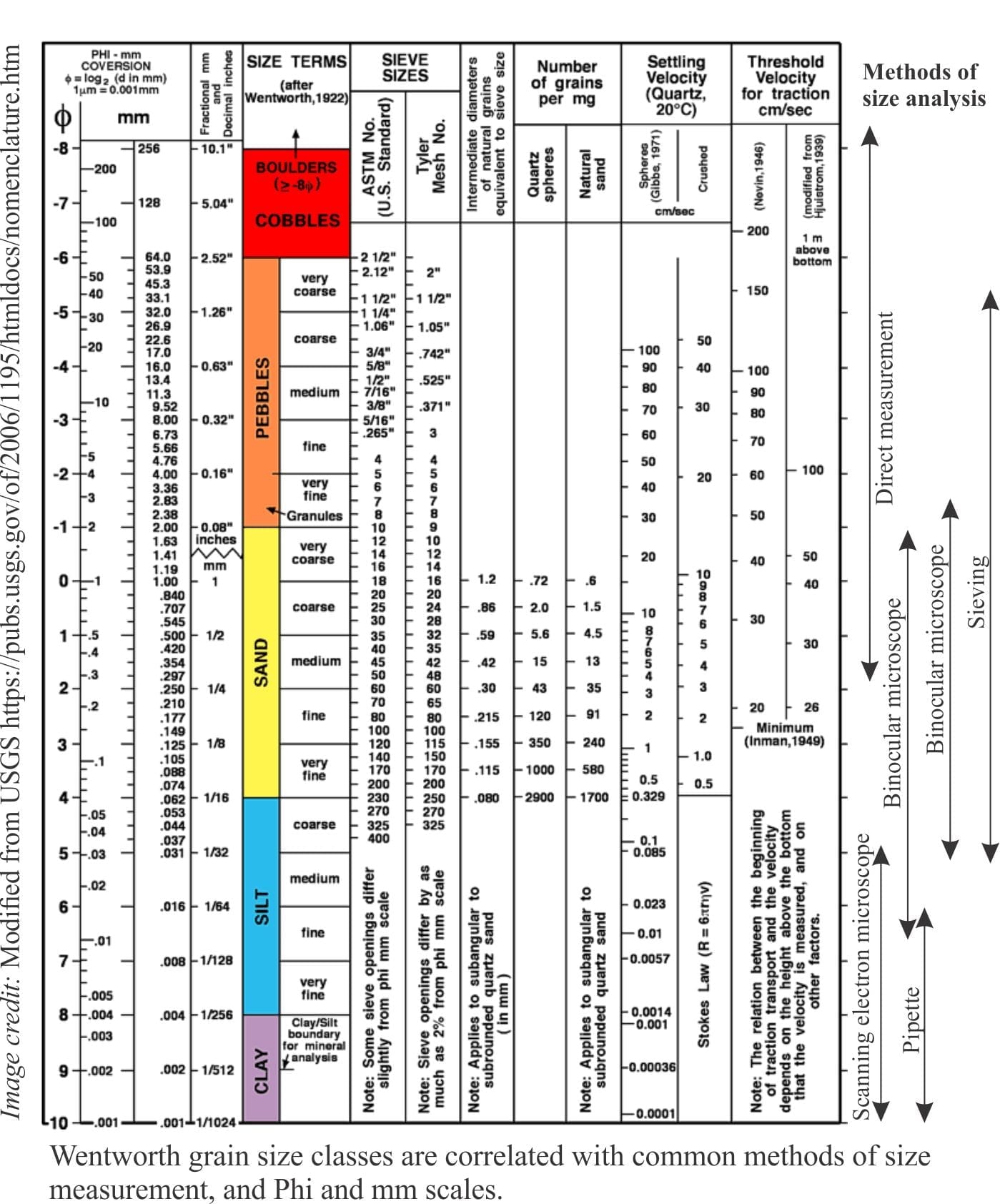This post is part of the How To… series
You have collected a sandstone that has been described as coarse-grained.
- What does ‘coarse’ refer to?
- What do we mean by ‘grain size’? and
- What parameters do we measure to make such a determination?
Grains, whether they are silt, sand or gravel, assume myriad shapes. Grain shape is determined by several factors, perhaps the most important being:
- Crystal properties such as habit and cleavage in the case of common minerals like quartz, feldspar or mica,
- Original texture or fabric in the parent rock from which the grains are derived,
- The mechanical and chemical stability of grains during transport, and
- Post-depositional changes like compaction (important in soft lithic fragments), size reduction by mineral dissolution or size enlargement by precipitation.
The problem of defining grain size boils down to one of defining the most useful shape. The image of a beach deposit at the top of the page serves to illustrate this. Clasts here include those that approximate spheres, are elongate, rod-like, blocky cubes, and those that are more flattened. To determine their size, do we measure maximum, intermediate or minimum diameters? Do we calculate their surface areas? Or do we assume they all approximate spheres and use a diameter that best fits each grain?
The answer – all of the above. Years of experience and experimentation have shown show that the most useful grain size measures depend on what it is we want to study (see the generalized list of analytical methods appended to the USGS Chart, below).
For example, if we are interested in how the sedimentary particles behave hydraulically (e.g. in channel flow or across a wind-blown sand dune) then we could choose a measure that reflects resistance to flow or drag. If we want a more descriptive measure for loose or disaggregated sand and gravel, then we might apply a sieve diameter (the minimum diameter that will pass through a particular sieve aperture). Measurement of very fine particles (clays) that uses pipettes or settling columns, relies on particle attributes such as settling velocity through a column of water, or with the advent of new laser technology, the light-scattering properties of clay-sized particles in a dispersion (with water) or solid state (laser diffraction and laser particle sizer).
In 1922 Chester Wentworth devised a grain size scale based on a geometric progression – this scale is still the most popular (The Journal of Geology, Vol. 30, No. 5 1922, pp. 377-392). Wentworth followed the reasoning advanced earlier by J. Udden, where a geometric progression based on ‘2’ (rather than a linear scale) is sensible because:
- It allows a useful subdivision of grain sizes in silts and sands (the most common clastic rock types),
- The grain size in samples that represent single grain populations tend to plot as straight lines on log and semilog graphs.
- In addition, we now know that small changes in the grain size of sands and silts have hydraulic significance and hence it is very useful to incorporate these size classes into our general classification. In comparison, small changes in the size of cobbles and boulders have little hydraulic significance.
For the Wentworth scale, each successive size class is twice the size in inches of the previous class – hence the geometric progression 1/16, 1/8, ¼, ½, 1, 2, 4 and so on (these days we work in millimeters).
Note that ‘clay’ in this context refers to a size class, and not a mineral class.
A modification of this scale was devised by Krumbein – the well-known Phi Scale (ϕ), that is calculated using the expression
Φ = -Log2 of the grain size in millimeters


The Phi scale simplifies size measurement (sieve mesh sizes usually quote a Phi interval), the graphical representation of grain size populations, and calculation of statistical measures like mean and sorting. The handy USGS chart above shows a comparison of grain size classes in relation to sieve sizes, settling velocities, and threshold velocities for initiation of grain movement.
We now have the tools to describe the grain size of clastic rocks where size classes like coarse-grained sand(stone) have corresponding size ranges expressed in millimeters and Phi values.
Some other useful links
Sedimentary structures: Fine-grained fluvial
Describing sedimentary rocks; some basics
Analysis of sediment grain size distributions
Crossbedding – some common terminology
The hydraulics of sedimentation: Flow Regime

